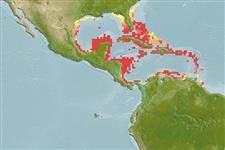>
Holocentriformes (Squirrelfishes, soldierfishes) >
Holocentridae (Squirrelfishes, soldierfishes) > Holocentrinae
Etymology: Sargocentron: Greek, sargos = sargus + Greek, kentron = sting (Ref. 45335).
More on author: Poey.
Environment: milieu / climate zone / depth range / distribution range
Ecologia
marino associati a barriera corallina; distribuzione batimetrica 1 - 30 m (Ref. 9710), usually ? - 22 m (Ref. 3156). Tropical; 33°N - 7°N, 99°W - 58°W
Western Atlantic: Bermuda and Florida, USA to northern South America.
Size / Peso / Age
Maturity: Lm ? range ? - ? cm
Max length : 15.0 cm TL maschio/sesso non determinato; (Ref. 26340)
Short description
Morfologia | Morfometria
Spine dorsali (totale): 11; Raggi dorsali molli (totale): 12; Spine anali 4; Raggi anali molli: 8. Body slender, sides compressed. Snout spinules prominent, spine extending into the posterior narial opening. White stripes on upper sides narrow, separated by broader dark bands (Ref. 37108). Body with alternate stripes of red and silvery white; spinous dorsal fin red, white at tips, with a large black spot between the first 3 or 4 spines (Ref. 13442).
Inhabit sandy, rocky and coral bottoms (Ref. 5521). More common on seaward reefs than on protected reefs. Retreat into recesses when alarmed (Ref. 9710). Nocturnal (Ref. 37108). Secretive, found deep in crevices between branches of live corals (Ref. 26938). Oviparous, with planktonic eggs and larvae (Ref. 240).
Life cycle and mating behavior
Maturità | Riproduzione | Deposizione | Uova | Fecundity | Larve
Smith-Vaniz, W.F., B.B. Collette and B.E. Luckhurst, 1999. Fishes of Bermuda: history, zoogeography, annotated checklist, and identification keys. American Society of Ichthyologists and Herpetologists Special Publication No. 4. 424 p. (Ref. 35505)
IUCN Red List Status (Ref. 130435)
Threat to humans
Reports of ciguatera poisoning (Ref. 30303)
Human uses
Informazioni ulteriori
Age/SizeAccrescimentoLength-weightLength-lengthLength-frequenciesMorfometriaMorfologiaLarveDinamica popolazioni larvaliReclutamentoAbbondanzaBRUVS
BibliografiaAcquacolturaProfilo di acquacolturaVarietàGeneticaElectrophoresesEreditarietàMalattieElaborazioneNutrientsMass conversion
Strumenti
Special reports
Download XML
Fonti Internet
Estimates based on models
Preferred temperature (Ref.
123201): 25.3 - 28.1, mean 27 °C (based on 158 cells).
Phylogenetic diversity index (Ref.
82804): PD
50 = 0.5000 [Uniqueness, from 0.5 = low to 2.0 = high].
Bayesian length-weight: a=0.01445 (0.00900 - 0.02322), b=2.98 (2.84 - 3.12), in cm total length, based on LWR estimates for this species & Genus-body shape (Ref.
93245).
Trophic level (Ref.
69278): 3.6 ±0.5 se; based on diet studies.
Resilienza (Ref.
120179): Alto, tempo minimo di raddoppiamento della popolazione meno di 15 mesi (Preliminary K or Fecundity.).
Fishing Vulnerability (Ref.
59153): Low vulnerability (10 of 100).
Nutrients (Ref.
124155): Calcium = 84.1 [33.3, 337.9] mg/100g; Iron = 0.636 [0.249, 1.978] mg/100g; Protein = 18.6 [17.3, 19.7] %; Omega3 = 0.151 [0.065, 0.351] g/100g; Selenium = 31.3 [17.7, 62.0] μg/100g; VitaminA = 78.2 [28.3, 219.0] μg/100g; Zinc = 2.29 [0.96, 4.45] mg/100g (wet weight);
